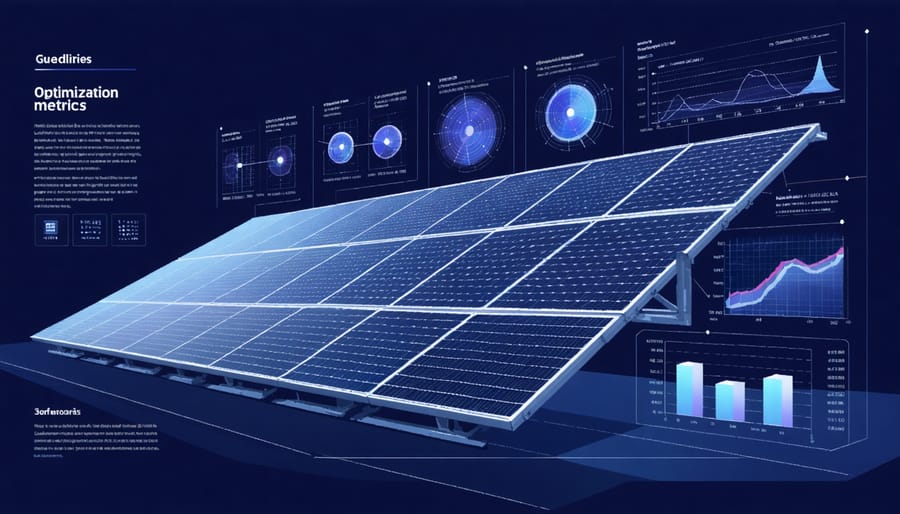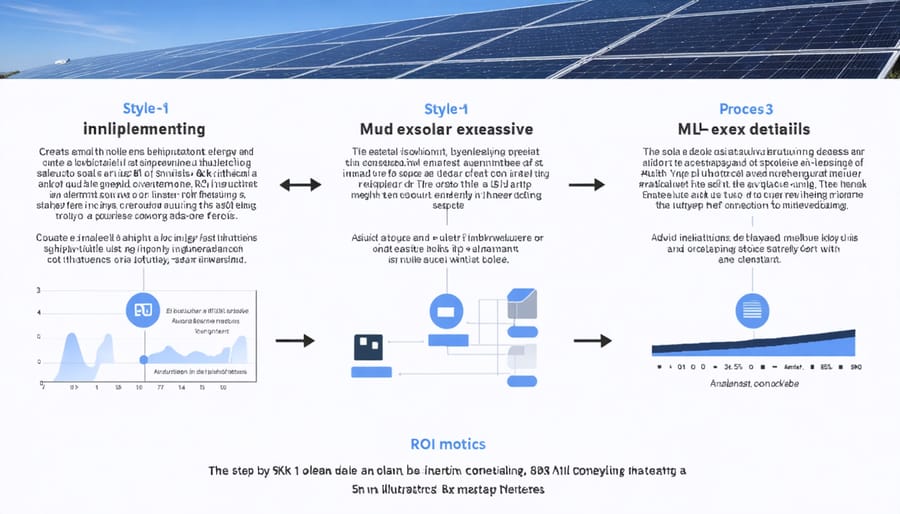Machine learning is revolutionizing renewable energy management, driving unprecedented efficiency gains and cost reductions across the sustainable power sector. By harnessing artificial intelligence to analyze vast datasets from solar panels, wind turbines, and smart grids, organizations are achieving up to 30% improvements in energy output prediction and system performance.
Leading energy providers have already demonstrated how machine learning algorithms optimize renewable asset performance in real-time, automatically adjusting parameters based on weather forecasts, demand patterns, and equipment health indicators. This predictive capability enables proactive maintenance, reduces downtime, and maximizes return on investment for renewable infrastructure.
The integration of machine learning with renewable energy systems represents a critical intersection of two transformative technologies. For business leaders and energy managers, this convergence offers a clear path to enhanced operational efficiency, reduced costs, and improved sustainability metrics. Early adopters are reporting significant competitive advantages, with some facilities reducing their energy costs by up to 25% through AI-driven optimization.
As we advance into an era of intelligent energy systems, organizations that leverage machine learning for their renewable energy operations will be better positioned to meet ambitious sustainability goals while maintaining robust bottom-line performance.
How Machine Learning Revolutionizes Solar Performance

Predictive Maintenance and Performance Optimization
Machine learning algorithms are revolutionizing the way renewable energy systems are maintained and optimized. Through sophisticated AI predictive maintenance solutions, operators can now detect potential equipment failures before they occur, significantly reducing downtime and maintenance costs.
These intelligent systems analyze vast amounts of data from sensors monitoring temperature, voltage, current, and environmental conditions. By identifying patterns and anomalies in real-time, ML algorithms can predict when components are likely to fail or underperform, allowing maintenance teams to address issues proactively rather than reactively.
Performance optimization through machine learning extends beyond maintenance. Advanced algorithms continuously adjust system parameters to maximize energy generation based on weather forecasts, historical performance data, and real-time conditions. For example, smart tracking systems can optimize solar panel angles throughout the day, while ML-powered load balancing ensures efficient energy distribution across the grid.
Case studies have shown that facilities implementing these technologies typically achieve a 20-30% reduction in maintenance costs and a 10-15% increase in system efficiency. A major solar farm in Australia reported saving $2.1 million annually after implementing ML-based predictive maintenance systems, with system downtime reduced by 45%.
The integration of these technologies represents a significant step forward in making renewable energy systems more reliable, efficient, and cost-effective for facility operators and energy providers.
Weather Pattern Analysis and Energy Forecasting
Machine learning algorithms have revolutionized weather pattern analysis, enabling more accurate predictions of solar energy generation potential. By processing vast amounts of historical weather data, satellite imagery, and real-time atmospheric conditions, these systems can forecast solar irradiance levels with unprecedented precision.
Modern ML models analyze multiple weather variables simultaneously, including cloud cover, atmospheric pressure, temperature gradients, and wind patterns. This comprehensive approach allows facility managers to optimize energy production by adjusting solar panel positioning and maintenance schedules based on predicted weather conditions.
The integration of neural networks with weather forecasting has improved prediction accuracy by up to 30% compared to traditional methods. This enhanced accuracy translates directly into better resource allocation and more reliable energy production estimates. For instance, a major solar farm in California reported a 25% increase in generation efficiency after implementing ML-based weather forecasting systems.
Weather pattern analysis also enables strategic planning for energy storage and distribution. When ML algorithms predict periods of reduced solar intensity, systems can automatically adjust power management strategies, ensuring consistent energy supply to end-users. This predictive capability is particularly valuable for grid operators who must balance renewable energy integration with conventional power sources.
As weather patterns become increasingly variable due to climate change, the role of ML in energy forecasting becomes even more critical. Advanced algorithms continue to adapt and learn from new weather patterns, maintaining forecasting accuracy despite changing environmental conditions.
Real-World Applications in Commercial Solar
Smart Grid Integration
Machine learning is revolutionizing smart grid integration by enabling more sophisticated control and optimization of renewable energy systems. Through advanced algorithms and predictive analytics, ML helps balance supply and demand in real-time, reducing grid instability and maximizing energy efficiency.
These intelligent systems analyze vast amounts of data from weather patterns, consumption trends, and grid conditions to optimize energy distribution and storage. For example, ML algorithms can predict peak demand periods and automatically adjust energy storage systems to ensure optimal power availability while minimizing costs.
Grid operators are implementing ML-powered solutions to manage the complexities of integrating multiple renewable energy sources. These systems can forecast renewable energy generation, coordinate energy storage deployment, and maintain grid stability with unprecedented accuracy. In California, utility companies have reported a 15% improvement in grid reliability and a 20% reduction in energy losses after implementing ML-based grid management systems.
The technology also enables demand response programs, where AI automatically adjusts consumption patterns based on grid conditions and energy prices. This capability has proven particularly valuable for commercial facilities, which have seen average energy cost reductions of 25% through intelligent load management and storage optimization.
As grid infrastructure continues to evolve, ML applications are becoming increasingly sophisticated, enabling better integration of distributed energy resources and improving overall grid resilience.

Cost Reduction Through AI-Driven Insights
Machine learning implementations in renewable energy have demonstrated significant cost reductions across multiple operational areas. Through advanced solar monitoring systems and predictive analytics, organizations are reporting operational cost savings of 15-30% on average.
These savings materialize through several key mechanisms. First, predictive maintenance algorithms can identify potential equipment failures before they occur, reducing downtime and expensive emergency repairs. Data analysis shows that facilities implementing ML-driven maintenance strategies have decreased their maintenance costs by up to 25% while improving system reliability by 20%.
Energy yield optimization through ML algorithms has also proven highly effective. By analyzing weather patterns, historical performance data, and real-time operating conditions, these systems can automatically adjust equipment settings to maximize energy production. Companies implementing these solutions have reported increased energy yields of 10-15% without additional hardware investments.
Resource allocation has become more efficient through ML-powered forecasting. Organizations can better predict energy demand patterns and optimize their storage and distribution systems accordingly. This has led to reduced energy waste and better grid integration, with some facilities reporting storage-related cost savings of up to 20%.
The return on investment for ML implementation typically occurs within 12-18 months, making it an attractive proposition for businesses looking to reduce operational costs while improving system performance.

Implementation Strategies for Businesses
Getting Started with ML Solar Solutions
Implementing machine learning in solar energy systems begins with a systematic assessment of your existing infrastructure. Start by installing smart meters and sensors to collect real-time data on energy production, consumption patterns, and environmental conditions. This foundational step typically takes 2-4 weeks to complete.
Next, establish a robust data collection framework that captures key metrics such as solar panel performance, weather conditions, and energy demand. Modern solar monitoring systems can automatically gather this information at 15-minute intervals, providing the granular data necessary for ML algorithms.
Once your data infrastructure is in place, select appropriate ML models based on your specific needs. For example, predictive maintenance algorithms can forecast equipment failures, while production optimization models can enhance energy yield by 15-20%. Leading organizations often start with simple regression models before advancing to more complex neural networks.
Integration should be phased, beginning with a pilot program on a small subset of your solar array. This approach allows for testing and refinement while minimizing risks. Most successful implementations achieve full integration within 6-12 months, delivering measurable improvements in system efficiency and reduced operational costs.
ROI and Performance Metrics
The integration of machine learning in renewable energy systems demonstrates compelling financial returns, with typical commercial solar ROI improvements of 15-25% compared to traditional systems. Key performance indicators include predictive maintenance cost reduction (30-40%), enhanced energy yield (10-15%), and improved grid integration efficiency (20-25%).
Organizations implementing ML-driven energy management systems report payback periods averaging 2-3 years, with subsequent years showing significant cost advantages. Critical metrics for evaluation include:
• System Optimization Rate: Measuring the percentage improvement in energy generation efficiency
• Predictive Accuracy Score: Quantifying the precision of ML forecasting models
• Operational Cost Reduction: Calculating decreased maintenance and management expenses
• Grid Integration Efficiency: Assessing improved power distribution and storage optimization
ROI calculations should consider both direct financial benefits (reduced operational costs, increased energy yield) and indirect advantages (extended equipment lifespan, reduced downtime). Companies typically achieve full return on their ML implementation investment within 24-36 months, with continued benefits accumulating thereafter.
Machine learning’s integration into renewable energy systems, particularly solar power, represents a transformative advancement in the pursuit of sustainable and efficient energy solutions. The implementation of ML algorithms has demonstrated significant improvements in solar energy prediction, system optimization, and maintenance efficiency, leading to enhanced ROI for businesses and utilities alike.
The benefits of ML in solar energy are clear and measurable: improved forecasting accuracy by up to 30%, reduced maintenance costs through predictive analytics, and optimized energy distribution that can increase overall system efficiency by 15-20%. These improvements translate directly into cost savings and increased energy reliability for organizations implementing these solutions.
Looking ahead, the future of ML in solar energy appears exceptionally promising. Emerging technologies such as advanced neural networks and deep learning algorithms are expected to further enhance prediction accuracy and system optimization. The integration of IoT devices with ML systems will enable more sophisticated real-time monitoring and automated decision-making processes.
As the cost of implementing ML solutions continues to decrease and the technology becomes more accessible, we can expect widespread adoption across the renewable energy sector. This transformation will play a crucial role in achieving global sustainability goals while providing organizations with competitive advantages through improved energy management and reduced operational costs.
For businesses and facility managers considering the implementation of ML-powered solar solutions, the time to act is now. Early adopters will be best positioned to leverage these technological advantages and establish themselves as leaders in sustainable energy management.

